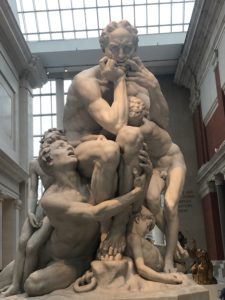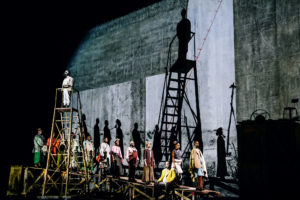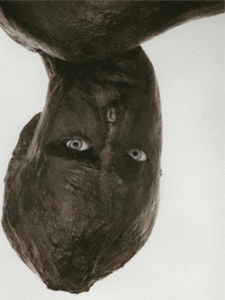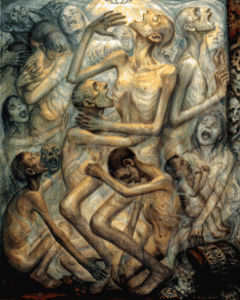 Aciman, Alexander.“Recapping Dante: Canto 33, or History’s Vaguest Cannibal.”
Aciman, Alexander.“Recapping Dante: Canto 33, or History’s Vaguest Cannibal.”
The Paris Review, Alexander Aciman ,
23 June 2014,
www.theparisreview.org/blog/2014/06/23/recapping-dante-canto-33-or-historys-vaguest-cannibal/.
When you first look at “Ugolino and His Sons” you can already notice that agony is the emotion expressed in this statue.You see it by the facial features and the body language. Reading the story behind it, made me even more impressed with the way Jean-Baptise Carpeaux captured the emotions of Ugolino and his sons according to their story accurately. Count Ugolino was punished for betraying his city, Pisa, by giving away fortresses to another town. He was locked up in a tower with his sons, when mealtime came, he realized that the doors were being nailed shut, and he also realized him and his sons were going to starve to death. He saw his children suffer from starvation and started to chew on his own fingers. By the time his children were dead, Ugolino was already driven by madness from starvation and started to eat the prisoner that was also there. The story told in this article, for me, further emphasizes how a story with so much tragedy can be depicted in a single work of art. It carries the emotion of it all and that’s why I chose the statue for my project.
 Dr. Steven Zucker and Dr. Beth Harris,
Dr. Steven Zucker and Dr. Beth Harris,
“Giotto, Arena (Scrovegni) Chapel (part 3 of 4),”
in Smarthistory, December 10, 2015, accessed December 6, 2018,
In this video, Dr. Steven Zucker and Dr. Beth Harris are in the Arena Chapel in Italy, and one of the paintings that they talk about is the Lamentation painted by Giotto. At first glance, without knowing any context, we see there is a lot of sadness because of the death christ. We see the expressions everyone is wearing and there is a lot of dark and dull colors which adds on to the mood that the painting is giving off. As Dr. Zucker and Dr. Harris begin to talk about the symbolism and the meanings in this painting, the emotion one sees and feels begins to intensify because of the powerful meaning behind the symbolism. One of the things that I felt was extremely powerful was the mention of the tree on the top right. The doctors explain that it might look dead but bring up the fact that it also maybe winters, and it will come to life again when spring comes. They mention that this may also be an analogy to Christ and his eventual resurrection. Another thing that I thought was powerful was the mention of the position Mary, was in. Her knee is propped up holding her deads sons body, she is bending forward, her body is twisted, her arms are also holding him up, and her face expression is of pure sorrow. The doctors conclude that it‘s almost like she is trying to wake him up and is in complete shock of his death and of the way it happened. Once you get context of these things, it brings on a whole new wave of emotion. It‘s very effective.
 Farago, Jason.“The African Toll of the Great War, in Song and Shadows.”
Farago, Jason.“The African Toll of the Great War, in Song and Shadows.”
The New York Times, The New York Times, 6 Dec. 2018,
www.nytimes.com/2018/12/06/arts/design/william-kentridge-park-avenue-armory.html?rref=collection%2Ftimestopic%2FArt∾tion=click&contentCollection=timestopics®ion=stream&module=stream_unit&version=latest&contentPlacement=10&pgtype=collection.
I wanted to include this because my project has a lot of statue work and paintings. “The Head and the Load,” is a play all about the fallen African soldiers that aren’t commemorated the way European soldier are commemorated. Farago writes, “The Head and the Load,” evokes these porters’ crushing, fatal labor in a long grief-stricken procession, backed by a plangent elegy from the marvelous Guinean singer and kora player N’Faly Kouyaté. The troupe marches one by one in front of Mr. Kentridge’s mucky charcoal animations, carrying cutout placards of flags, boats, gramophones and planes, as well as portrait busts of African intellectuals and an effigy of Raoul Hausmann’s “Mechanical Head,” a Dada artifact of 1919. Their real shadows intermingle with projected ones, creating an infinite funerary march of porters and matériel,” I chose this article because it shows another form of art that is useful in portraying emotion in the story it is telling. It doesn’t all have to a still-life work of art to be empathetic. Dialogue, costumes, and music can also be effective.

 Hyman, Erin Williams.
Hyman, Erin Williams.
“Crouching Woman, Hidden Story: Erin Hyman on Kiki Smith’s Lilith.”
Open Space, 18 Sept. 2013,
openspace.sfmoma.org/2013/09/beyond-belief-erin-hyman/.
“Lilith” is one of my favorite sculptures of all time. She breaks boundaries, and I just love her unique story. Upon looking at this, someone can easily get spooked out. Everything about her is just weird and eerie, the position she is in, the roughness of her body, and lastly, the most terrifying thing about her, is her eyes. Her eyes are the only light colored part of her body and they are made of glass which makes her even more scarier because it’s almost as if she is staring right at you. Although you are creeped out, you also can’t help but feel curiosity. Before Eve was created from Adam’s rib, God had created man and women from dust. That women being Lilith, because both of them were made from dust, Lilith saw herself as Adam’s equal and did not want to be submissive to him. She fled Eden and wandered the earth punishing men and stealing babies. This is impressive because we see a break from the type of woman we usually see in art. We usually see some sort of fragility and softness in their face or in their pose in but here we the exact opposite. We see her body parts covered by her pose, we see the unevenness on her, and we she is just unearthly in every way. Hyman writes, “The sculpture of Lilith, like the morphing stories that have evolved around her name, remains wild, suspended, resisting any attempt to pin her down,” This fits to my theme because it is representing emotion and a story, but in a different way. It represents femininity in its genesis and firmness. Everything about “Lilith” is amazing.
 Olere, David.
Olere, David.
“Gassing.”
A Teachers Guide to the Holocaust,
fcit.usf.edu/holocaust/gallery2/D54.htm.
This painting is very hard to look at and to take in. Unfortunately, this painting does depict a reality. This shows Jews in a gas chamber in their final moments. Art is filled with a lot of mythology, but it is also filled with a lot of heartbreaking truths. Art is unfiltered and unapologetic and although it is horrifying, it is important for pieces like this to exist, because things like this cannot be forgotten. The extermination of six-million Jews was one of the most atrocious things that has happened in history and one of the most disturbing things about the Holocaust was the fact that many people were aware about these killings but nothing was done for a while. In the painting, we see the ghostly figures of Jews who actually looked like that because of the extreme starvation they were put through, we see them all crammed up, we see woman and babies included, and their faces of absolute agony. In the bottom right corner, we also see a can that says Zyklon B with the Star of David right next to it as if it was carved on the floor. Nazi’s would cram so many Jews in a small chamber and poor the murderous gas inside. This is another perfect example of a painting that creates such heartbreaking emotion and makes you empathize along with it.


